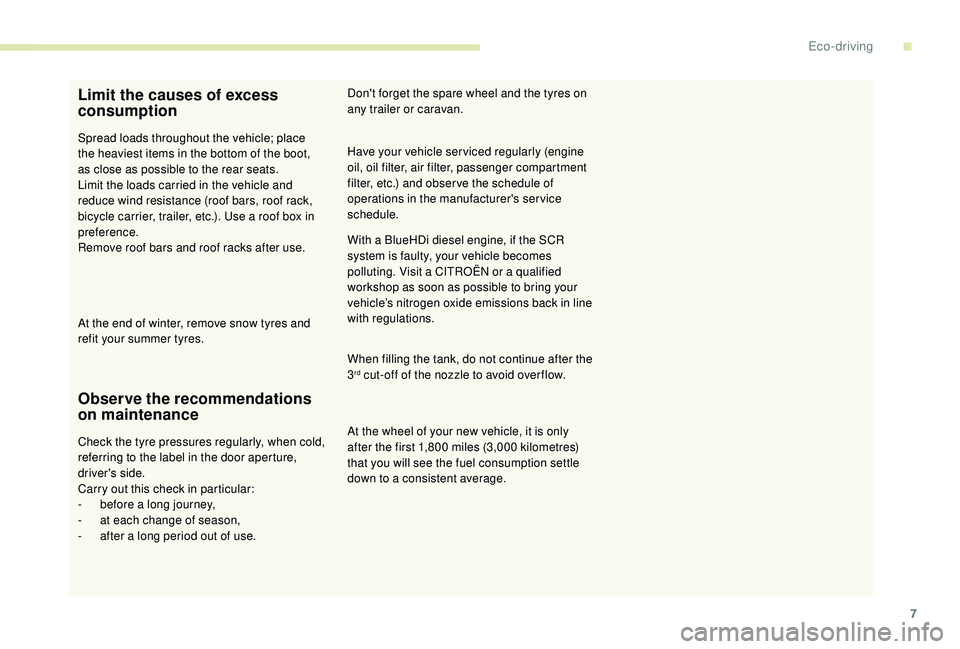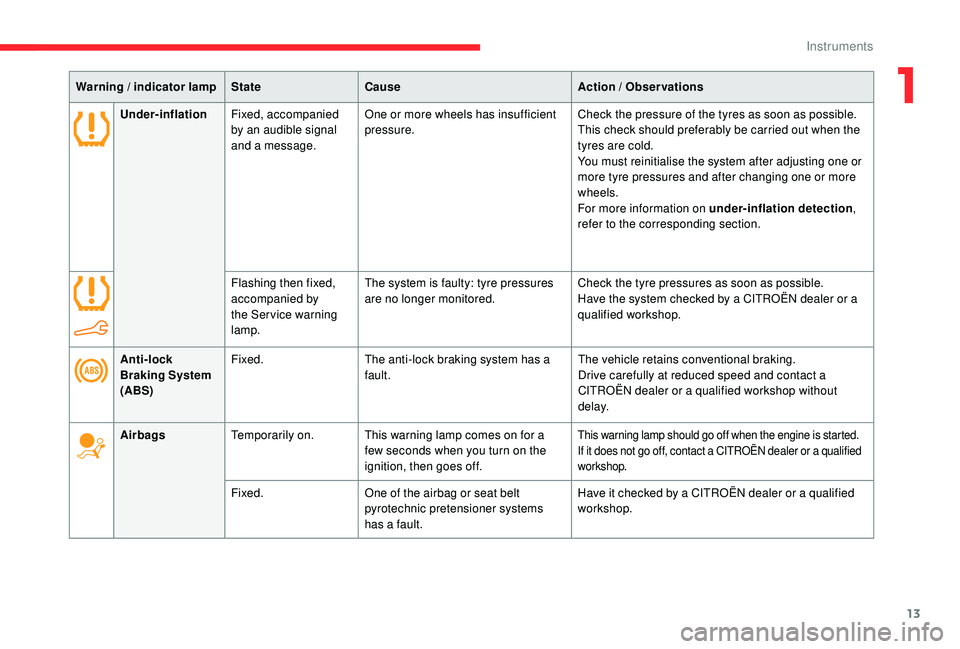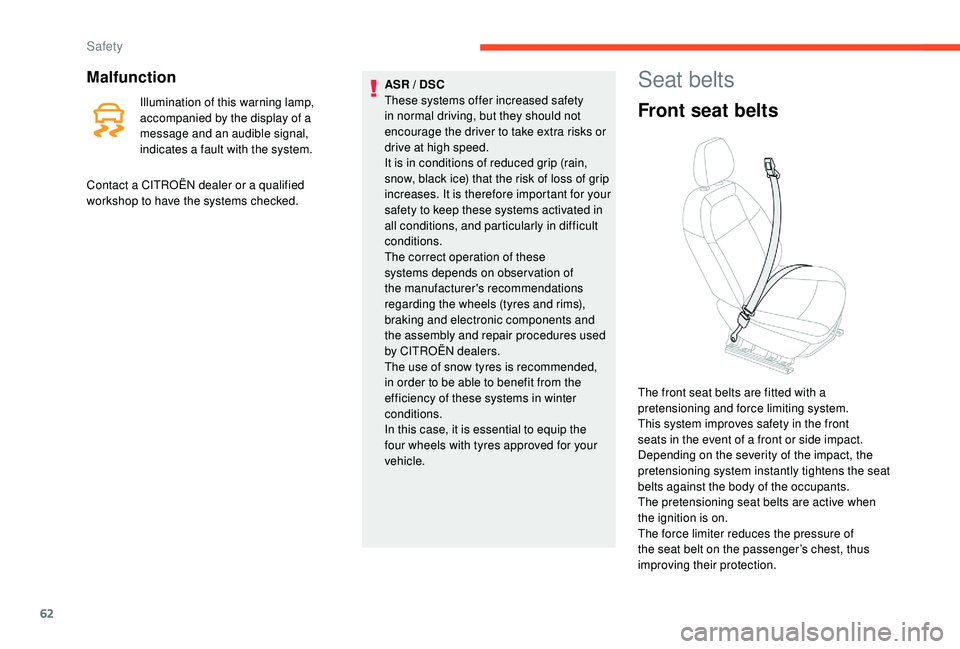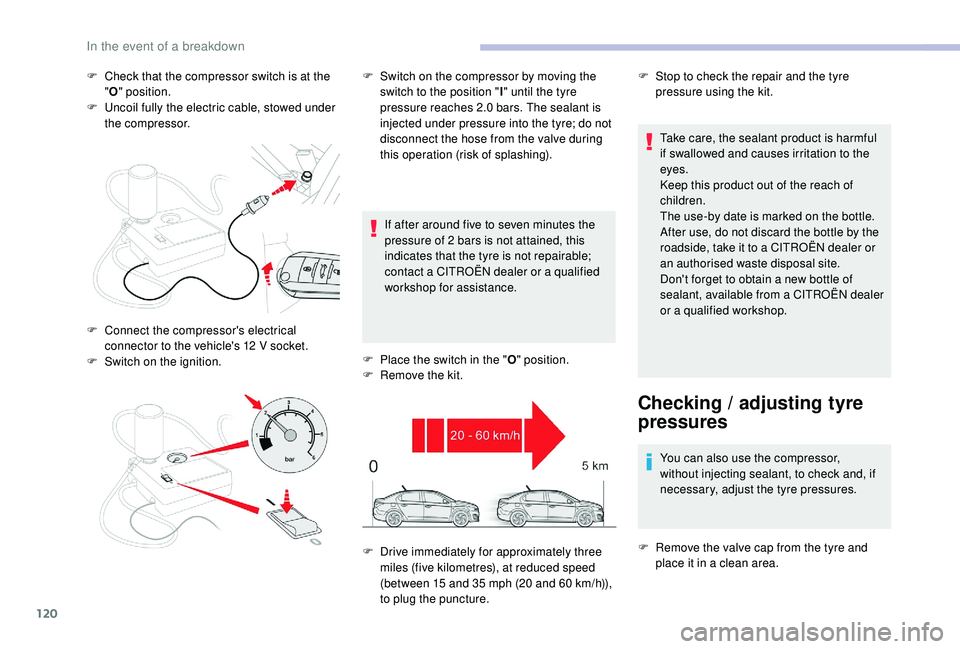tyre pressure CITROEN C-ELYSÉE 2022 Handbook (in English)
[x] Cancel search | Manufacturer: CITROEN, Model Year: 2022, Model line: C-ELYSÉE, Model: CITROEN C-ELYSÉE 2022Pages: 260, PDF Size: 8.4 MB
Page 9 of 260

7
Limit the causes of excess
consumption
Spread loads throughout the vehicle; place
the heaviest items in the bottom of the boot,
as close as possible to the rear seats.
Limit the loads carried in the vehicle and
reduce wind resistance (roof bars, roof rack,
bicycle carrier, trailer, etc.). Use a roof box in
preference.
Remove roof bars and roof racks after use.
At the end of winter, remove snow tyres and
refit your summer tyres.
Observe the recommendations
on maintenance
Check the tyre pressures regularly, when cold,
referring to the label in the door aperture,
driver's side.
Carry out this check in particular:
-
b
efore a long journey,
-
a
t each change of season,
-
a
fter a long period out of use. Have your vehicle ser viced regularly (engine
oil, oil filter, air filter, passenger compartment
filter, etc.) and obser ve the schedule of
operations in the manufacturer's service
schedule. Don't forget the spare wheel and the tyres on
any trailer or caravan.
With a BlueHDi diesel engine, if the SCR
system is faulty, your vehicle becomes
polluting. Visit a CITROËN or a qualified
workshop as soon as possible to bring your
vehicle’s nitrogen oxide emissions back in line
with regulations.
When filling the tank, do not continue after the
3
rd cut-off of the nozzle to avoid over flow.
At the wheel of your new vehicle, it is only
after the first 1,800
miles (3,000 kilometres)
that you will see the fuel consumption settle
down to a consistent average.
.
Eco-driving
Page 15 of 260

13
Under-inflationFixed, accompanied
by an audible signal
and a message. One or more wheels has insufficient
pressure.
Check the pressure of the tyres as soon as possible.
This check should preferably be carried out when the
tyres are cold.
You must reinitialise the system after adjusting one or
more tyre pressures and after changing one or more
wheels.
For more information on under-inflation detection
,
refer to the corresponding section.
Flashing then fixed,
accompanied by
the Ser vice warning
lamp. The system is faulty: tyre pressures
are no longer monitored.
Check the tyre pressures as soon as possible.
Have the system checked by a CITROËN dealer or a
qualified workshop.
Anti-lock
Braking System
(ABS) Fixed.
The anti-lock braking system has a
fault. The vehicle retains conventional braking.
Drive carefully at reduced speed and contact a
CITROËN dealer or a qualified workshop without
d e l ay.
Airbags Temporarily on. This warning lamp comes on for a
few seconds when you turn on the
ignition, then goes off.
This warning lamp should go off when the engine is started.
If it does not go off, contact a CITROËN dealer or a qualified
workshop.
Fixed.One of the airbag or seat belt
pyrotechnic pretensioner systems
has a fault. Have it checked by a CITROËN dealer or a qualified
workshop.
Warning / indicator lamp
StateCause Action / Observations
1
Instruments
Page 63 of 260

61
Anti-lock braking system
(ABS) and electronic brake
force distribution (EBFD)
The fixed illumination of this warning
lamp signals that there is a fault with
the ABS.
Illumination of this warning lamp,
coupled with the STOP and ABS
warning lamps, accompanied by
the display of a message and an
audible signal, signals that there is a
fault with the electronic brake force
distribution (EBFD).
Normal operation of the ABS may make
itself felt by slight vibration of the brake
pedal.
When braking in an emergency, press
firmly without ever releasing the
pressure. When changing wheels (tyres and rims),
ensure that these are approved for your
vehicle.Anti-slip regulation (ASR)
/ Dynamic stability control
(DSC)
Operation
These systems are activated automatically
every time the vehicle is started.
They come into operation in the event of a
problem of grip or trajectory.
Deactivation
In exceptional conditions (starting a vehicle
which is bogged down, stuck in snow, on soft
ground, etc.), it may be advisable to deactivate
these systems, so that the wheels can turn
freely and regain grip.
Reactivate the systems as soon as the level of
grip permits.
The vehicle retains conventional braking. Drive
carefully at moderate speed.
Contact a CITROËN dealer or a qualified
workshop as soon as possible.
You must stop as soon as it is safe to do so.
Call a CITROËN dealer or a qualified
workshop. This is indicated by this warning
lamp flashing in the instrument
panel.F
P
ress this button until the
corresponding symbol appears
in the instrument panel.
The button indicator lamp comes on.
The ASR and DSC systems will no longer have
an effect on engine operation or the brakes in
the event of an involuntary change of trajectory.
Reactivation
The ASR system is reactivated automatically
every time the ignition is switched back on or
from 30
mph (50 km/h).
Below 30
mph (50 km/h), you can reactivate it
manually.
F
P
ress this button again to
reactivate the system manually.
The button indicator lamp goes off.
5
Safety
Page 64 of 260

62
Malfunction
Illumination of this warning lamp,
accompanied by the display of a
message and an audible signal,
indicates a fault with the system.ASR / DSC
These systems offer increased safety
in normal driving, but they should not
encourage the driver to take extra risks or
drive at high speed.
It is in conditions of reduced grip (rain,
snow, black ice) that the risk of loss of grip
increases. It is therefore important for your
safety to keep these systems activated in
all conditions, and particularly in difficult
conditions.
The correct operation of these
systems depends on obser vation of
the manufacturer's recommendations
regarding the wheels (tyres and rims),
braking and electronic components and
the assembly and repair procedures used
by CITROËN dealers.
The use of snow tyres is recommended,
in order to be able to benefit from the
efficiency of these systems in winter
conditions.
In this case, it is essential to equip the
four wheels with tyres approved for your
vehicle.
Seat belts
Front seat belts
The front seat belts are fitted with a
pretensioning and force limiting system.
This system improves safety in the front
seats in the event of a front or side impact.
Depending on the severity of the impact, the
pretensioning system instantly tightens the seat
belts against the body of the occupants.
The pretensioning seat belts are active when
the ignition is on.
The force limiter reduces the pressure of
the seat belt on the passenger’s chest, thus
improving their protection.
Contact a CITROËN dealer or a qualified
workshop to have the systems checked.
Safety
Page 93 of 260

91
Under-inflation detection
System which automatically checks the
pressures of the tyres while driving.
The system monitors the pressure in all four
tyres, as soon as the vehicle is moving.
It compares the information given by the wheel
speed sensors with reference values, which
must be reinitialised ever y time the tyre
pressures are adjusted or a wheel changed.
The system triggers an alert as soon as it
detects a drop in the pressure of one or more
tyres.
The under-inflation detection system does
not replace the need for vigilance on the
part of the driver.
This system does not avoid the need to
check the tyre pressures (including the
spare wheel) every month as well as
before a long journey.
Driving with under-inflated tyres worsens
road-holding, lengthens braking distances,
causes premature wear of the tyres,
particularly in adverse conditions (heavy
loads, high speeds, long journeys). Driving with under-inflated tyres
increases fuel consumption.
The inflation pressures defined for your
vehicle can be found on the tyre pressure
label.
For more information on the
Identification markings , refer to the
corresponding section.
Checking tyre pressures
This check should be done when the tyres
are "cold" (vehicle stopped for 1
hour or
after a journey of less than 6
miles (10 km)
at moderate speeds).
Other wise, add 0.3
bar to the pressures
shown on the label.
Under-inflation alert
This warning is indicated by
continuous illumination of the
warning lamp, an audible signal and
a message displayed on the screen. F
R
educe speed immediately, avoid excessive
steering movements and sudden braking.
F
S
top as soon as it is safe to do so.
The loss of pressure detected does not
always cause visible bulging of the tyre.
Do not rely on a simple visual check.
F
I
f you have a compressor (such as the one
in the temporary puncture repair kit), check
the pressures of the four tyres when cold.
If it is not possible to carry out this check
immediately, drive carefully at reduced
speed.
or
F
I
n the event of a puncture, use the
temporary puncture repair kit or the spare
wheel (depending on equipment).
The warning remains active until the
system is reinitialised.Reinitialisation
The system must be reinitialised after any
adjustment to the pressures of one or more
tyres, and after changing one or more wheels.
6
Driving
Page 94 of 260

92
Before reinitialising the system, ensure
that the pressure of the four tyres
is correct for the conditions of use
of the vehicle and conforms to the
recommendations on the tyre pressure
label.
The under-inflation alert can only be relied
on if the system has been reinitialised with
the pressure of the four tyres correctly
adjusted.
The under-inflation detection system
does not give a warning if a pressure is
incorrect at the time of reinitialisation.
Without audio system
F Open the glove box.
F
H
old this button down. A high-pitched audible signal indicates that the
reinitialisation has not been carried out.
The new pressure parameters registered are
considered reference values by the system.
With audio system
Reinitialisation is confirmed by a low-pitched
audible signal.
F
P
ress the MENU
button for access to the
main menu.
F
P
ress the "
7" or " 8" button to select the
" Personalisation-configuration " menu
and confirm by pressing the central button.
F
P
ress the "
7" or " 8" button to select the
" Define vehicle parameters " menu and
confirm by pressing the central button.
F
P
ress the "
7" or " 8" button to select the
" Driving assistance " category and confirm
by pressing the central button. F
P
ress the "
7" or " 8" button to select " Ty r e
pressures ", then "Reinitialisation ", then
confirm by pressing the central button.
A message confirms the reinitialisation
operation.
With touch screen
The system reinitialisation request
can be configured in the Driving/
Vehicle menu.
The under-inflation alert can only be relied
on if the system has been reinitialsed with
the pressure of the four tyres correctly
adjusted.
Snow chains
The system does not have to be
reinitialised after fitting or removing snow
chains.
Driving
Page 95 of 260

93
Operating fault
The flashing and then fixed illumination of the
under-inflation warning lamp accompanied
by illumination of the Ser vice warning lamp
indicates a fault with the system.
A message appears, accompanied by an
audible signal.
In this case, under-inflation monitoring of the
tyres is no longer assured.
Have the system checked by a CITROËN
dealer or a qualified workshop.Before doing anything to the system,
the pressure of the four tyres must be
checked and the system reinitialised.
Speed limiter
System which prevents the
vehicle from exceeding the speed
programmed by the driver.
Once the speed limit is reached, the
accelerator pedal no longer has any effect.
The speed limiter is switched on manually:
it requires a programmed speed of at least
20
mph (30 km/h).
The speed limiter is switched off by manual
operation of the control.
The programmed speed can be exceeded
temporarily by pressing the accelerator firmly.
To return to the set speed, simply slow down to
a speed below the programmed speed.
The set speed remains in the system memory
when the ignition is switched off.
The speed limiter cannot in any
circumstances replace the need to respect
speed limits, or the vigilance of the driver.
Steering mounted controls
1.Speed limiter mode selection wheel.
2. Value decrease button.
3. Value increase button.
4. Speed limiter on/off button.
Displays on the instrument
panel
The programmed information is grouped
together in the instrument panel screen.
5Speed limiter on / off indication.
6 Speed limiter mode selected.
7 Programmed speed value.
6
Driving
Page 121 of 260

119
The vehicle's electrical system allows the
connection of the compressor for long
enough to inflate a tyre after a puncture
repair.
Composition of the kit
1.12 V compressor, with built-in pressure
gauge.
2. Bottle of sealant, with built-in hose.
3. Speed limit sticker.
The speed limit sticker must be secured
to the interior of the vehicle in the driver's
field of vision, to remind you that a wheel
is in temporary use. Do not exceed a speed of 50
mph
(80 km/h) when driving with a tyre repaired
using this type of kit.
Repair procedure
F Switch off the ignition.
F S ecure the speed limit sticker inside the
vehicle.
F
U
ncoil the pipe stowed under the
compressor.
Avoid removing any foreign bodies which
have penetrated into the tyre.
F
C
onnect the pipe from the compressor to
the bottle of sealant. F
R
emove the valve cap from the tyre to be
repaired, and place it in a clean area.
F
T
urn the sealant bottle over and secure it in
the cut-out provided on the compressor.
F
C
onnect the hose from the bottle of sealant
to the valve of the tyre to be repaired and
tighten firmly.
8
In the event of a breakdown
Page 122 of 260

120
F Check that the compressor switch is at the "O " position.
F
U
ncoil fully the electric cable, stowed under
the compressor.
If after around five to seven minutes the
pressure of 2
bars is not attained, this
indicates that the tyre is not repairable;
contact a CITROËN dealer or a qualified
workshop for assistance.
F
P
lace the switch in the "O" position.
F
R
emove the kit.Take care, the sealant product is harmful
if swallowed and causes irritation to the
eyes.
Keep this product out of the reach of
children.
The use-by date is marked on the bottle.
After use, do not discard the bottle by the
roadside, take it to a CITROËN dealer or
an authorised waste disposal site.
Don't forget to obtain a new bottle of
sealant, available from a CITROËN dealer
or a qualified workshop.
Checking / adjusting tyre
pressures
You can also use the compressor,
without injecting sealant, to check and, if
necessary, adjust the tyre pressures.
F
R
emove the valve cap from the tyre and
place it in a clean area.
F
C
onnect the compressor's electrical
connector to the vehicle's 12
V socket.
F
S
witch on the ignition. F
S
witch on the compressor by moving the
switch to the position " I" until the tyre
pressure reaches 2.0
bars. The sealant is
injected under pressure into the tyre; do not
disconnect the hose from the valve during
this operation (risk of splashing). F
S
top to check the repair and the tyre
pressure using the kit.
F
D
rive immediately for approximately three
miles (five kilometres), at reduced speed
(between 15
and 35
mph (20
and 60
km/h)),
to plug the puncture.
In the event of a breakdown
Page 123 of 260

121
F Check that the compressor switch is at the "O " position.
F
U
ncoil fully the electric cable, stowed under
the compressor.
F
U
ncoil the pipe stowed under the
compressor.
F
S
crew the pipe onto the valve and tighten
f i r m l y.
F
C
onnect the compressor's electric plug to
the vehicle's 12
V socket. F
S
witch on the ignition.
F
S
witch on the compressor by moving the
switch to the position " I" and adjust the
pressure as shown on the vehicle tyre
pressure label. To deflate: press the black
button on the compressor hose by the valve
connector.
F
O
nce the correct pressure is reached, move
the switch to the " O" position.
F
R
emove the kit then stow it.Tyre under-inflation detection
Should the pressure of one or more tyres
be adjusted, it is necessary to reinitialise
the under-inflation detection system.
For more information on Under-inflation
detection
, refer to the corresponding
section. After a tyre repair, the warning
lamp will remain on until the
system is reinitialised.
For more information on Tyre under-
inflation detection , refer to the
corresponding section.
8
In the event of a breakdown